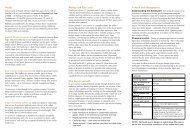Bushland Weeds Manual - Environmental Weeds Action Network
Bushland Weeds Manual - Environmental Weeds Action Network
Bushland Weeds Manual - Environmental Weeds Action Network
You also want an ePaper? Increase the reach of your titles
YUMPU automatically turns print PDFs into web optimized ePapers that Google loves.
94<br />
Chapter 8 Herbicide Use<br />
in <strong>Bushland</strong><br />
The issue of herbicide use in bushland is sometimes a<br />
sensitive one. This chapter aims to give the reader a<br />
greater understanding of herbicides, their fate in the<br />
environment and the legislation regarding their use.<br />
It sometimes does this by directing the reader to<br />
alternate sources of information. The role of spray<br />
contractors in bushland regeneration is also discussed<br />
and some basic information given on the herbicides<br />
mentioned throughout this manual.<br />
Using herbicides in bushland<br />
Many professional bush regenerators and members of<br />
community groups are uncomfortable with the use of<br />
herbicides in bushland, others actively oppose it.<br />
Nevertheless, herbicide use in bushland management<br />
appears to have increased in recent times. Bush<br />
regenerators try to use herbicides only in very targetspecific<br />
situations: The injection of herbicide into the<br />
trunk of trees, spot spraying individual grass clumps<br />
with selective herbicide or the wiping of leaf blades for<br />
cormous species like Watsonia. It is often a choice<br />
between the minimal damage done by carefully targeted<br />
herbicides and the loss of animal and plant biodiversity<br />
caused by dense invasions of weeds. When applied<br />
carefully by trained personnel with a detailed<br />
knowledge of herbicides and of the flora and bushland<br />
they are working in, herbicides can be an invaluable<br />
weed management tool:<br />
• Herbicides can control more weeds more quickly and<br />
with less labour than appropriate physical methods.<br />
• They cause fewer physical disturbances to the soil<br />
and surrounding vegetation - limiting erosion and<br />
reducing the creation of microsites for germination<br />
of other weed species.<br />
• They avoid the carrying of weed material through<br />
good condition bushland, decreasing the dispersal<br />
of seeds and reproductive propagules.<br />
• Grass-selective herbicides are available that cause<br />
little or no damage to species not of the grass<br />
(Poaceae) family.<br />
• Broad-spectrum herbicides can be applied<br />
selectively to the target plant.<br />
Duty of care<br />
Before using herbicides in bushland, or employing<br />
someone else to use them for you, personal safety of<br />
the applicator and others in the area need to be<br />
considered.<br />
People who use herbicides in bushland, including<br />
volunteers, have a ‘duty of care’ to the environment,<br />
members of the public and themselves. A clear,<br />
informative explanation of the section in the<br />
Occupational Safety and Health Act 1984 involving<br />
chemicals in the workplace and working with<br />
pesticides, is available online at http://www.safetyline.wa.<br />
gov.au/pagebin/hazshazd0018.htm. Briefly:<br />
• Applicators (including volunteers) should have<br />
appropriate training in the safe storage, handling,<br />
preparation and use of any herbicide they use.<br />
• Current Material Safety Data Sheets (MSDS) must<br />
be on hand and available for perusal by any<br />
persons coming in contact with the herbicide.<br />
• The public should be made aware of any chance<br />
they may come into contact with a chemical.<br />
• All hazardous substances kept on the premises<br />
should be named in a poisons register and the<br />
associated MSDS stored with them.<br />
• Herbicides should be transported and stored safely.<br />
• Herbicides must be labelled correctly. It is an<br />
offence to permanently store registered herbicides<br />
in anything other than their original containers<br />
with their original labels. Temporary containers<br />
must be labelled with the product name and the<br />
appropriate risk and safety phrases.<br />
• Information and training should be provided to<br />
group members on potential health risks and toxic<br />
effects, control measures, correct use of control<br />
methods and correct care and use of personal<br />
protective equipment and clothing.<br />
Personal care<br />
The application of herbicides involves a high degree of<br />
personal care. Long-term effects of most herbicides are<br />
unknown and it is safest to avoid contamination.<br />
Herbicide labels carry a protective equipment list that<br />
identifies the minimum safety requirements. Protective<br />
equipment should be worn during:<br />
• Mixing of herbicides.<br />
• Application.<br />
• Entering a treated area before the herbicide has<br />
dried or dissipated.<br />
• Further steps that aid in personal hygiene are<br />
listed in Box 8.1.<br />
In Australia a poisons schedule system is in place. The<br />
schedule number indicates the level of toxicity of the<br />
chemical to humans and the precautions that should<br />
be taken. The poisons schedule does not give an<br />
indication of danger to the environment. All<br />
pesticides, including herbicides, are classed as either<br />
S5, S6, S7 or exempt from scheduling, depending on<br />
their degree of hazard:<br />
• Exempt from scheduling – pesticides that present<br />
little hazard in their use. Non-toxic.<br />
• Schedule 5 (domestic poisons) – poisons that<br />
require caution in their handling, use and storage.<br />
Low toxicity.<br />
• Schedule 6 (industrial poisons) – dangerous<br />
poisons available for agricultural and industrial<br />
application. Moderately toxic.<br />
• Schedule 7 (special poisons) – substances of<br />
exceptional danger that require special precautions<br />
in their manufacture and use. Extremely toxic.<br />
A comprehensive chart, detailing schedules for a wide<br />
range of herbicides and protective precautions that<br />
should be taken is available from the Kondinin Group<br />
(Ph: 9478 3343; web site www.kondinin.com.au).



